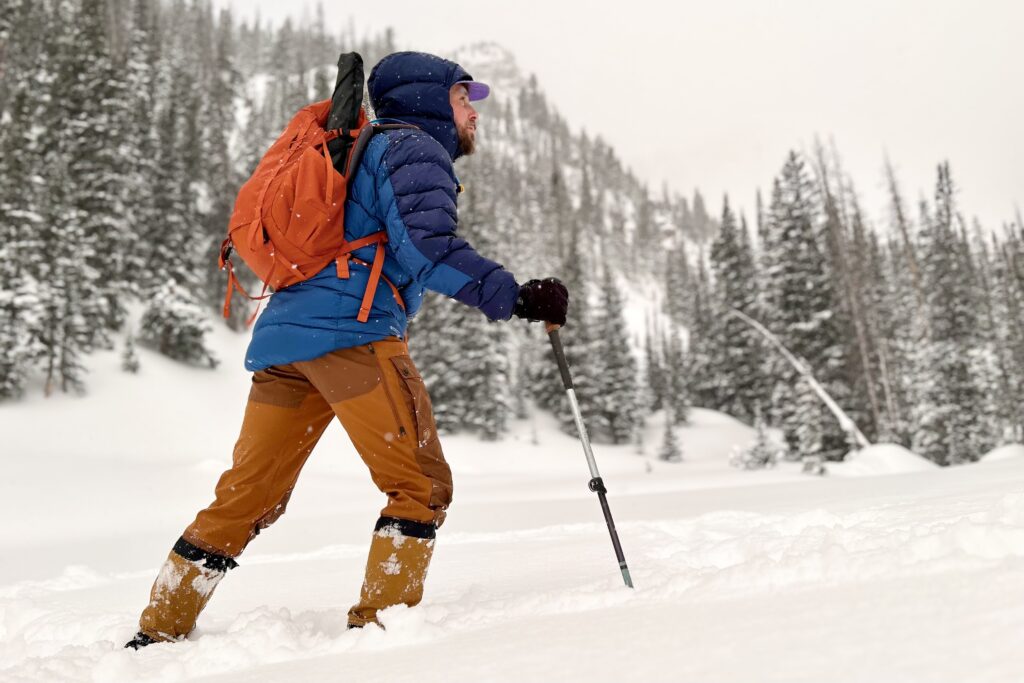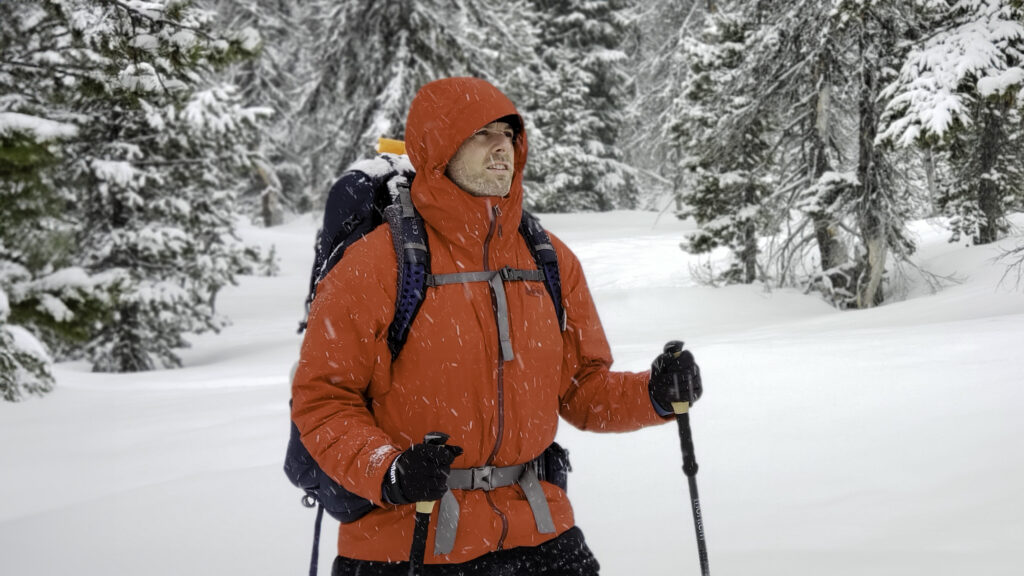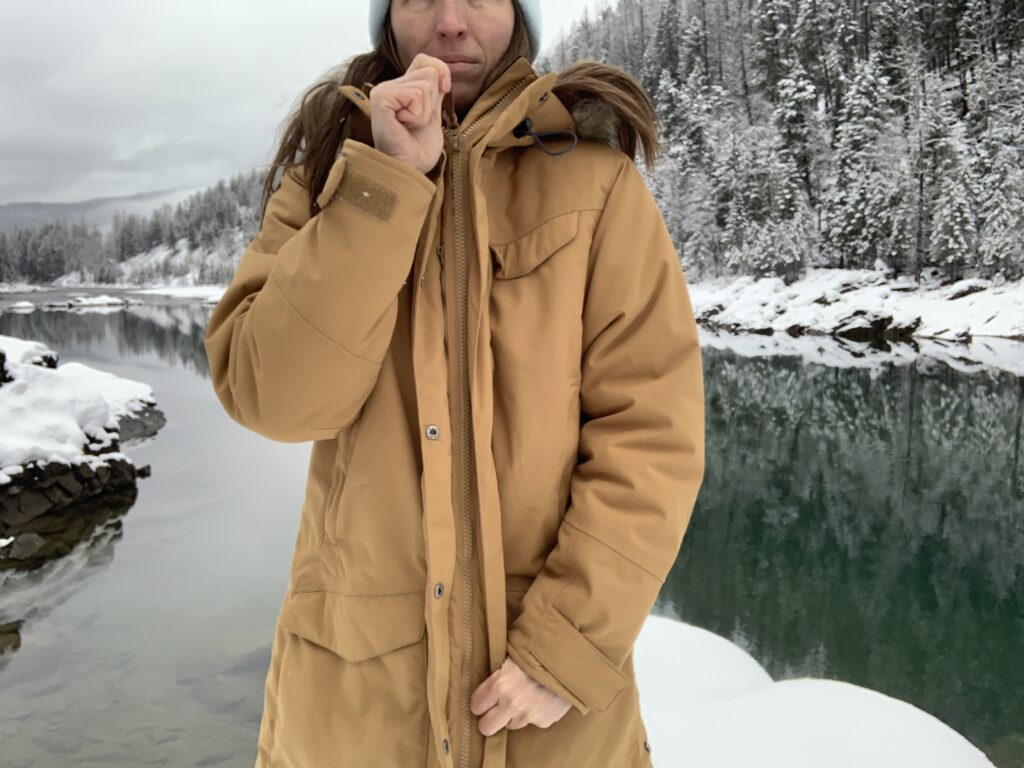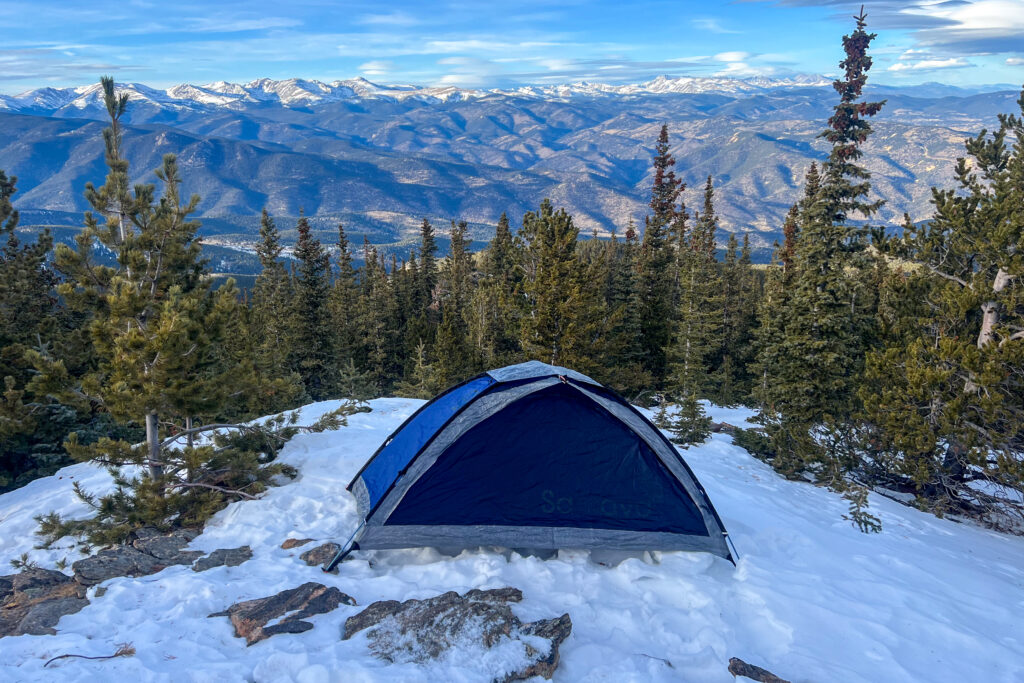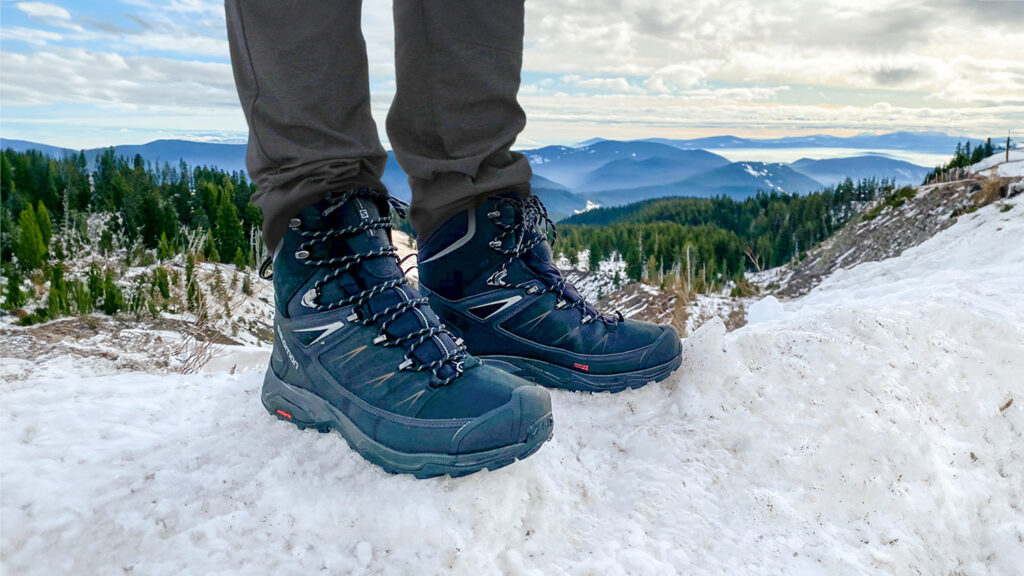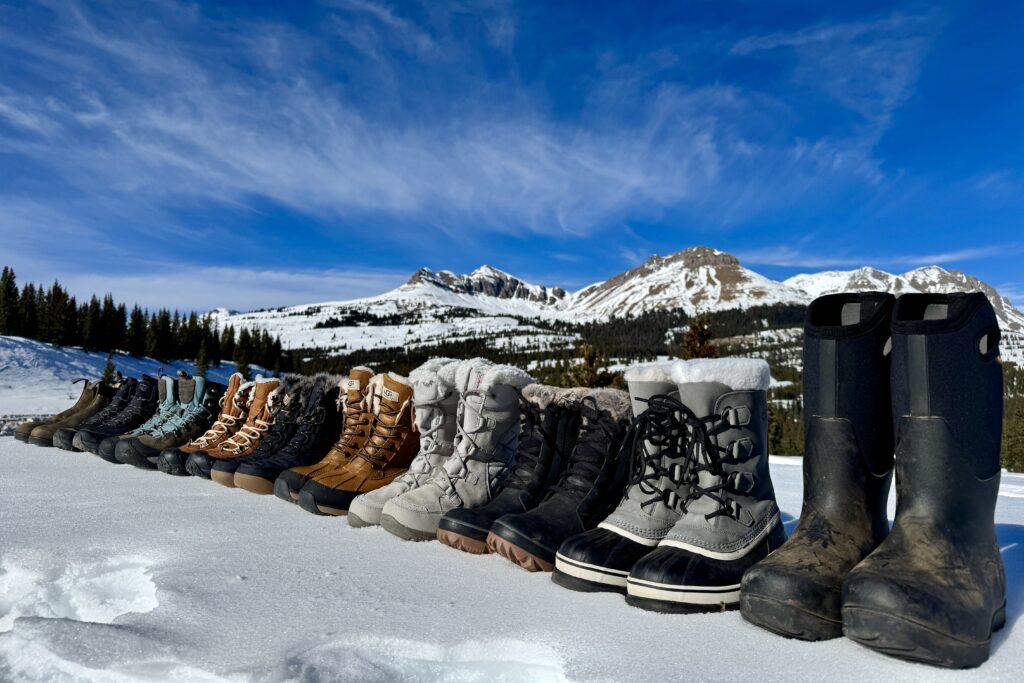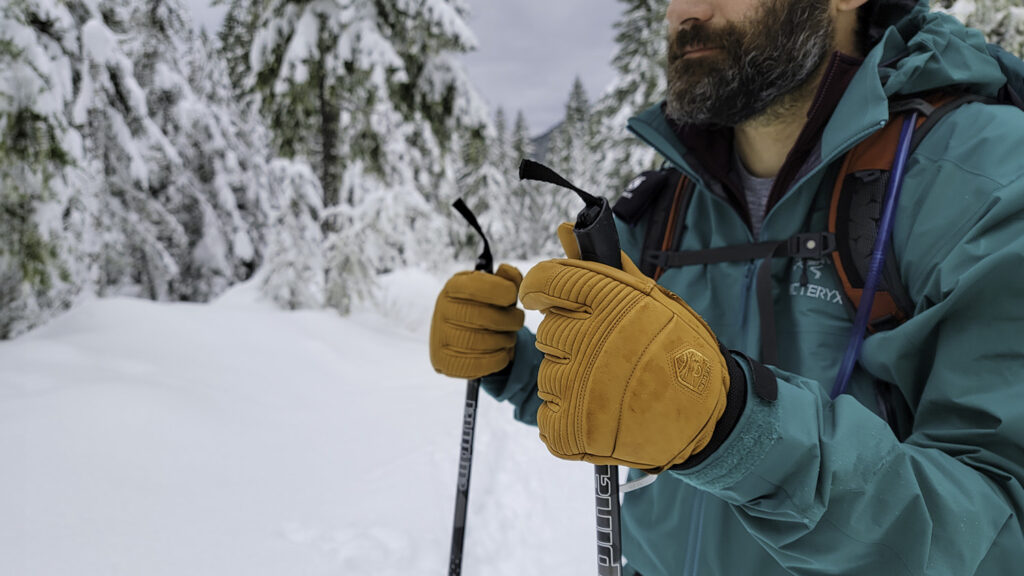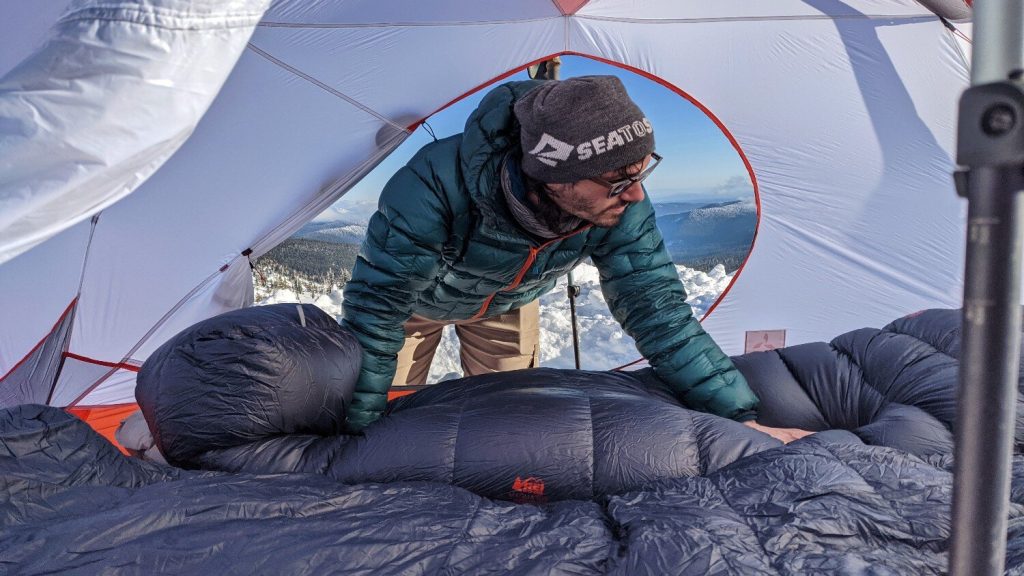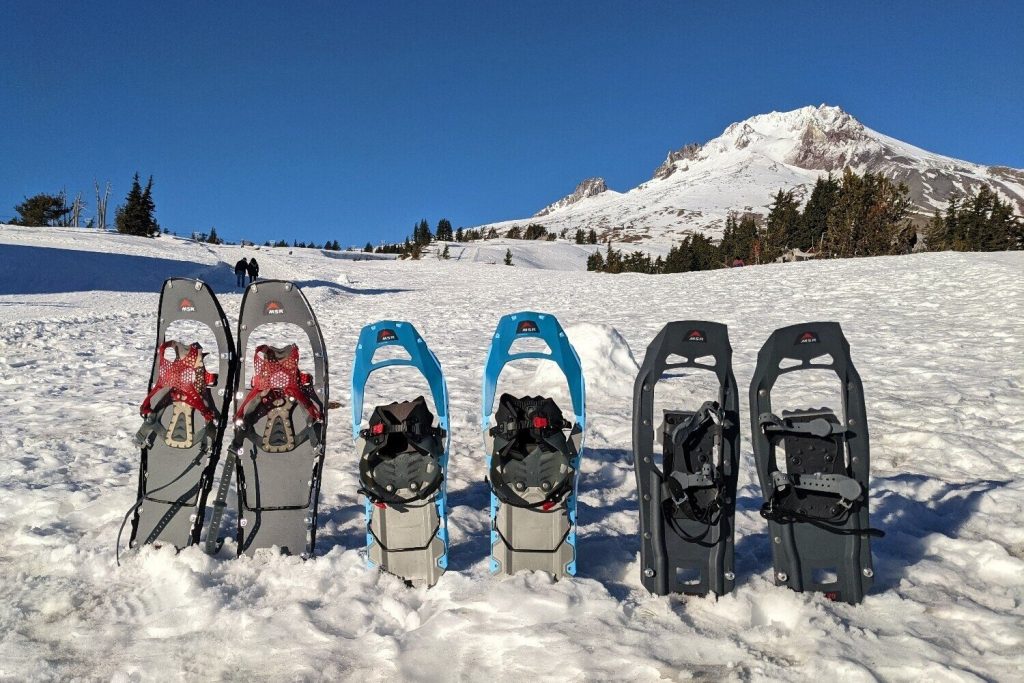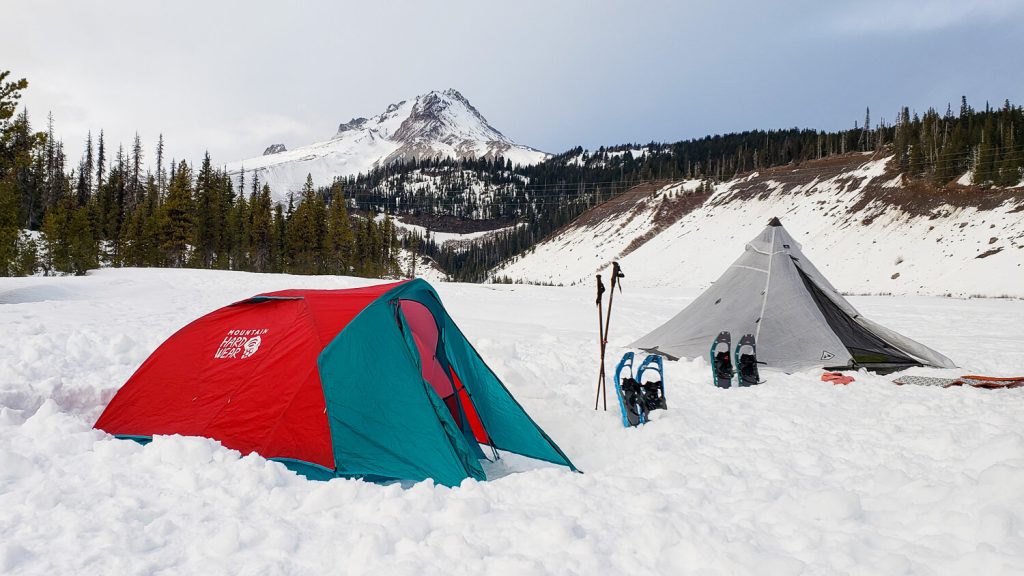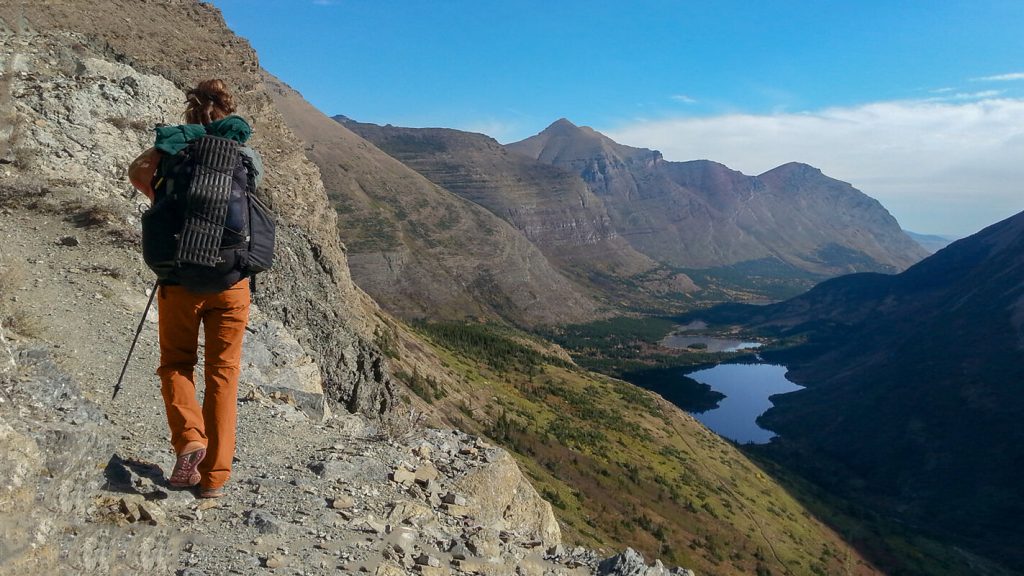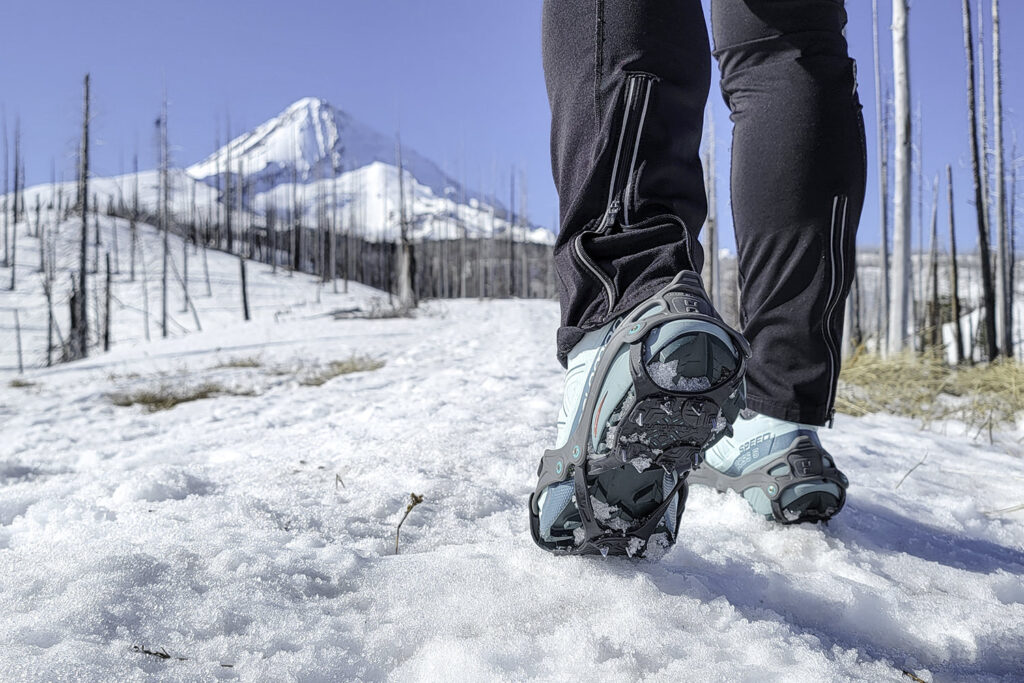
We’ve tediously researched 40 sets of spikes, studs, and chains to find the ones with the best traction, ease of use, durability, and weight. We picked out our favorites and hiked mile after mile on soft snow, hard pack, and urban environments to test them out side by side. We even tackled icy, class four scrambles in the Rocky Mountains.
From our extensive testing, we’ve derived recommendations for all conditions, featuring brands such as Black Diamond, Kahtoola, Hillsound, and Yaktrax. This guide will help point you towards the best ice cleats for your personal needs.
And for more info, check out some of our other most popular gear guides:
Quick Picks for Ice Cleats/Winter Traction
Check out this quick list of our favorite traction devices, or continue scrolling to see our full list with in-depth reviews.
Best Running Spikes: Black Diamond Distance Spikes ($100)
Best Hiking Spikes: Kahtoola MICROspikes ($75)
Most Aggressive Hiking Cleats: Kahtoola EXOspikes ($65)
Best Shoulder Season Cleats: Hillsound Trail Crampon ($85)
Great for Running in Mild Conditions: Kahtoola NANOspikes ($55)
Best Semi-Technical Spikes: Kahtoola K-10 ($120)
Best Budget Buy: Yaktrax Chains ($30)
Best at Shedding Snow: Yaktrax Diamond Grip ($55)
What’s new
Our team of analysts has tested and re-tested our favorite cleats with some securely holding their spot on the list despite strong, emerging competitors.
- Strong performers like the Kahtoola MICROspikes, Hillsound Trail Crampons, and Kahtoola EXOspikes continue to impress us and aren’t going anywhere any time soon.
- For the serious winter trail-runners, we’ve added the Black Diamond Distance Spike for its ultra lightweight and aggressive traction.
Winter Traction Devices Overall Testing Scores
Product Comparison Table
| oSort | Product | Price | Weight | Type | Best Use | Traction | Fit | Ease of Use | Weight & Packability | Durability | 0 |
Black Diamond Distance Spikes See at Amazon See at Backcountry |
$100 | 4.1 oz. | Spikes | Trail running | 4.5 | 5 | 4.6 | 5 | 4.4 | 1 |
Kahtoola MICROspikes View at REI View at Amazon |
$75 | 11.9 oz. | Spikes | Hiking | 4.7 | 4.7 | 4.8 | 4.6 | 4.7 | 2 |
Kahtoola EXOspikes View at REI View at Amazon |
$65 | 7.3 oz. | Studs | Trail running & hiking | 4.4 | 5.0 | 4.0 | 4.8 | 4.7 | 3 |
Hillsound Trail Crampon View at REI View at Amazon |
$85 | 1 lb. 0.3 oz. | Spikes | Hiking & backpacking; mixed mountain terrain | 4.8 | 5.0 | 4.0 | 4.4 | 4.6 | 4 |
Kahtoola NANOspikes View at REI View at Amazon |
$55 | 7.4 oz. | Studs | Walking, road running, paved trails | 4.0 | 4.9 | 3.8 | 4.8 | 4.6 | 5 |
Kahtoola K10 View at Backcountry View at Amazon |
$120 | 1 lb. 7.6 oz. | Strap-On Crampon | Hiking & non-technical mountaineering | 5.0 | 4.5 | 3.7 | 3.6 | 5.0 | 6 |
Yaktrax Chains View at Amazon View at Taktrax |
$40 | 9.6 oz. | Chains | Walking; mixed ice, gravel & hard surfaces | 4.2 | 4.5 | 3.8 | 4.6 | 4.4 | 7 |
Yaktrax Diamond Grip View at REI View at Amazon |
$55 | 9.7 oz. | Steel beads | Walking & light hiking | 4.1 | 4.5 | 3.8 | 4.5 | 4.3 |
|---|
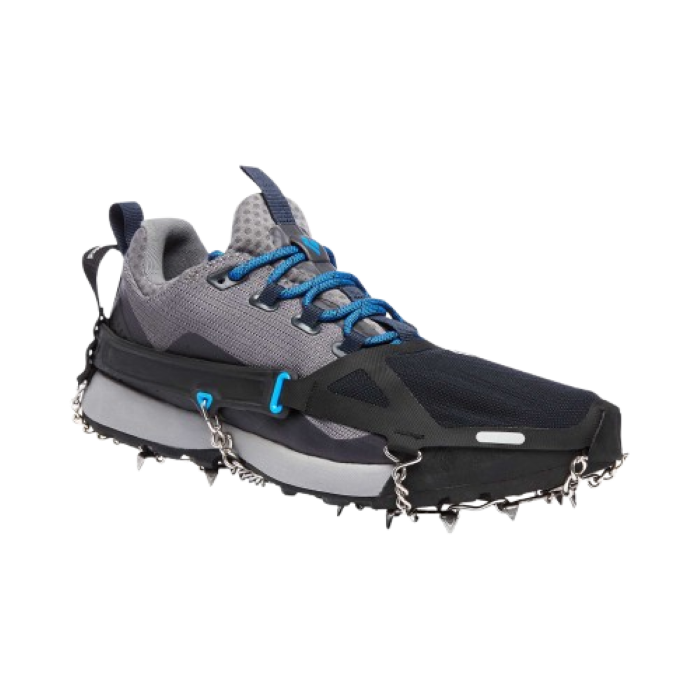
Black Diamond Distance Spikes
Best Running Spikes
CleverHiker Rating: 4.7/5.0
Price: $100
Weight: 4.1 oz.
Best Use: Trail running
Pros
- Very light and packable
- Secure and comfortable fit
- Aggressive traction for running
Cons
- Expensive
- Not the most durable
The Black Diamond Distance Spikes are aggressive trail-running traction devices made to tackle the most challenging winter terrain. The 8mm spikes provide significantly more traction than most trail-running cleats while still remaining versatile enough for dry trail surfaces like dirt and gravel. They seamlessly transition across varied terrain, so you can keep up your pace without having to constantly take the spikes on and off.
The spikes do, however, come on and off quite easily when desired. The thumb loop on the heel allows for quick adjustments, and the front and back are easily identifiable.
The soft shell toe cap is the standout feature on the Distance Spikes, providing a secure and comfortable fit as well as maximum weight savings. The spikes stayed snug against the bottom of our trail runners even after several miles on trail. They are low-profile enough to avoid unwanted snagging but big enough to provide ample traction.
In addition to its comfortable fit, the mesh toe cap cuts down on weight. At just 57.5 grams per foot, the Distance Spikes are the lightest on our list. They also come with a handy stuff sack that takes up a minimal amount of valuable pack space.
Although the performance of the Distance Spikes never fails to impress, the durability leaves a bit to be desired considering its premium price point. Budget shoppers or bushwackers venturing off of blazed trails might want to look into other alternatives.
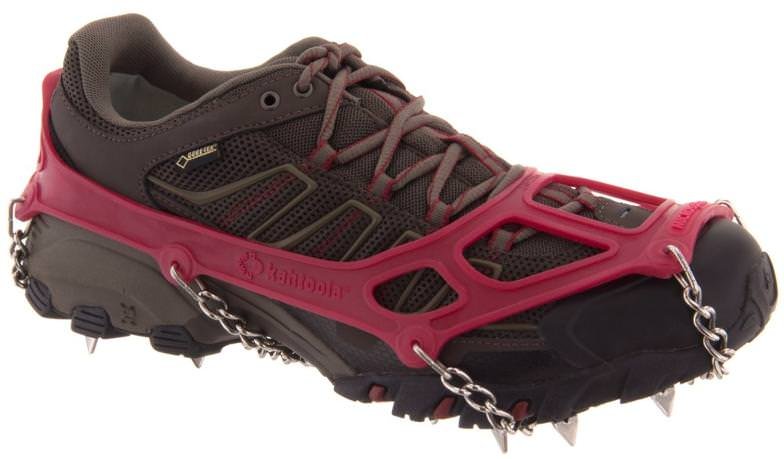
Kahtoola MICROspikes
Best Hiking Spikes
CleverHiker Rating: 4.7/5.0
Price: $75
Weight: 11.9 oz.
Type: Spikes
Best Use: Hiking
Pros
- Aggressive traction
- Durable
- Relatively compact
Cons
- A bit expensive
- Heavier than some
If you’re having a hard time deciding on one pair of traction devices to do it all, the Kahtoola MICROspikes are our go-to recommendation. They offer the best balance of traction, comfort, weight and packability, providing a ton of versatility and value.
The 9.5mm spikes are the perfect size to instill confidence on steeper, icy terrain while not being overly clumsy when crossing sections of dry and rocky trail. Though we consider them best suited for ice and packed snow, you won’t find yourself needing to remove the spikes often to cross dirt, mud, or even the occasional wooden bridge.
Weighing about 169 grams per foot, the MICROspikes are definitely noticeable but light enough not to cause any major foot fatigue. The MICROspikes gave us no trouble on long winter hikes, but we have better recommendations for serious trail runners.
The durable thermoplastic elastic harness remains stretchy at subzero temperatures and provides a secure and comfortable fit. The attachment points to the stainless steel chains and spikes are reinforced for a durable construction that is easy to repair if anything springs loose.
The spikes are straightforward to use with a front that is clearly marked to avoid any confusion when pulling them on and off. Our only gripe was the occasional need to snug up the heel as it tends to slip down while hiking.
The MICROspikes are a tad more expensive than other options on our list, but we think the value and versatility more than justifies the investment.
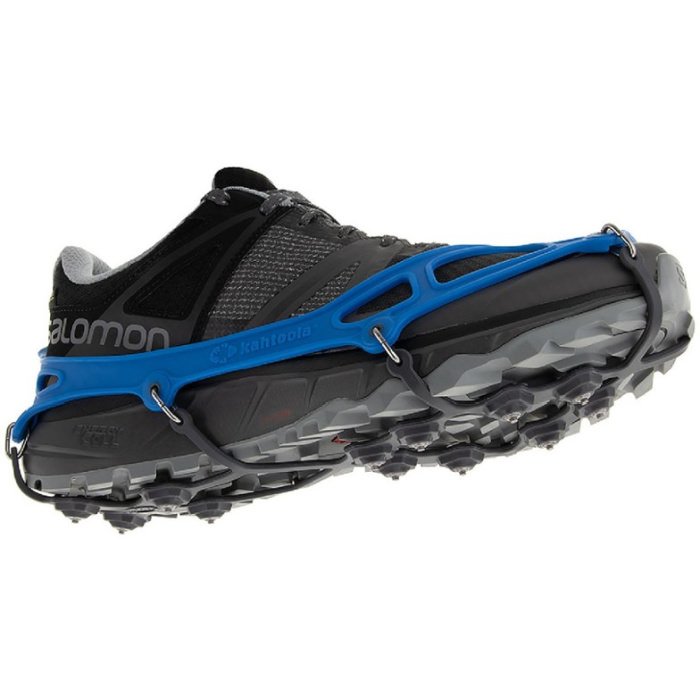
Kahtoola EXOspikes
Best Shoulder Season Cleats
CleverHiker Rating: 4.6/5.0
Price: $65
Weight: 7.3 oz.
Type: Studs
Best Use: Trail running & hiking
Pros
- Versatile
- Lightweight
- Comfortable
- Excellent value
Cons
- A bit bulkier than some
- Less aggressive traction
We love the versatility, comfort, and construction of the Kahtoola EXOspikes. They aren’t quite as aggressive as spiked devices, but they are the most versatile and effective of all the stud style devices we tested.
The super durable, 7.4mm long tungsten carbide studs are made in a concave pattern that grips ice from all angles, and they are raised off the footbed to help in fresh powder. The low profile design minimizes snag risks and also makes them more manageable on stretches of dry, rocky terrain. The EXOspikes become ineffective in more than an inch or two of fresh snow, but we found them to excel in slick, packed snow.
The fit and user friendliness of the EXOspikes remains on par with typical Kahtoola construction. The front is clearly marked and the snug, TPE elastic harness stays stretchy even in frigid temperatures. The minimal weight of these spikes allows for all day comfort with minimal need to remove or readjust.
The overall construction of the EXOspikes points to plenty of longevity. The elastic is thick and durable, attachment points are reinforced and easily repairable, and the tungsten carbide studs are 100 times more abrasion resistant than steel. The only point of concern is the semi-rigid TPU traction matrix, which could weaken if stressed in the same place over time.
Overall, the EXOspikes impressed us across widely varying terrain. They’re perfect for trail runs at lower elevations where you’ll be encountering patches of slush, snow, and ice. For such a versatile and comfortable traction device, the EXOspikes provide a ton of value for their price point.
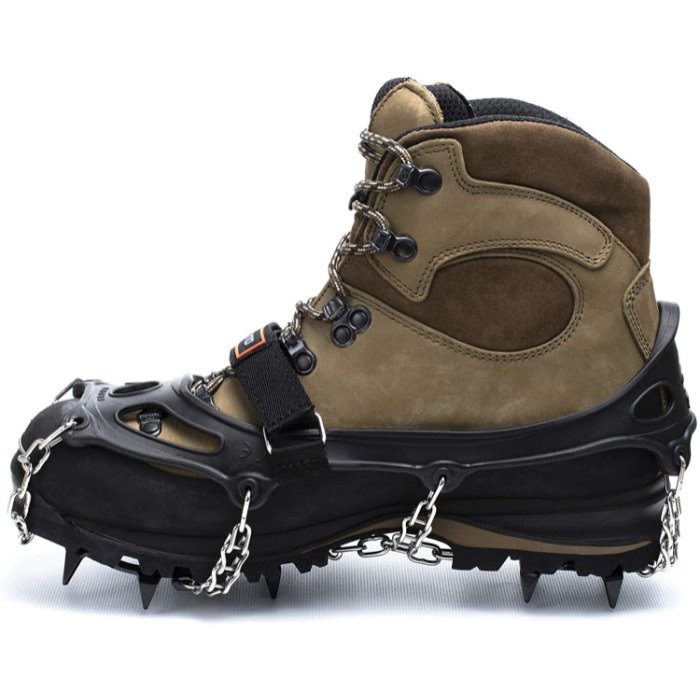
Hillsound Trail Crampon
Most Aggressive Hiking Spikes
CleverHiker Rating: 4.6/5.0
Price: $85
Weight: 1 lb. 0.3 oz.
Type: Spikes
Best Use: Hiking & backpacking; mixed mountain terrain
Pros
- Aggressive traction
- Durable
- Secure fit
Cons
- Tall
- Take a little longer to put on
- Too aggressive for dry terrain
The Hillsound Trail Crampons effectively bridge the gap between lightweight hiking spikes and true mountaineering crampons. They feature eleven carbon steel spikes that are ⅔” in length with very pointy tips. The tips create a ton of extra traction on ice and slick, packed snow, but they’re overkill on dry trails. We even got them stuck in a wooden bridge on one occasion. However, on all other surfaces – from ice to fresh snow – the added traction is much appreciated.
The fit provided by the elastomer harness and velcro strap is comfortable and secure, especially on hiking and winter boots. The fit can be a little sloppy on trail runners and hiking shoes.
The Trail Crampons aren’t the best for extended, all day use. They’ll add about a half pound to each foot, or a full pound to your pack weight when not in use. The extra weight is worth noting for extended treks when foot fatigue is a concern. Fortunately, they come with a durable stuff sack that is “puncture proof” to keep the rest of your gear safe from the spikes.
Although they’re one of the burlier options on our list, the Trail Crampons suffer from a few durability flaws. The carbon steel spikes are less wear resistant and more prone to rust than stainless steel. Plus, the vulnerable attachment points to the elastomer harness are not reinforced. However, the plate design and doubled up chains help to increase overall robustness.
Ultimately, the Hillsound Trail Crampons are best used on fully covered winter trails or when the trail gets particularly spicy. They are some of the more expensive cleats on our list. But with proper care, they should last long enough to get your money’s worth.
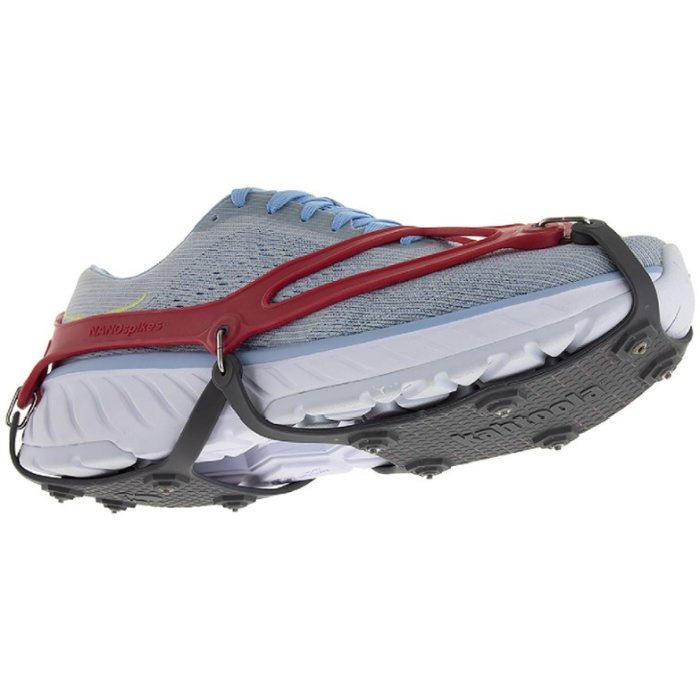
Kahtoola NANOspikes
Great for Running in Mild Conditions
CleverHiker Rating: 4.4/5.0
Price: $55
Weight: 7.4 oz.
Type: Studs
Best Use: Walking, road running, paved trails
Pros
- Lightweight
- Affordable
- Low profile
Cons
- Less aggressive traction
- Not ideal for rugged terrain or inclines
The Kahtoola NANOspikes provide versatile traction that excels on ice and packed snow on gentle to moderate terrain. They are an excellent choice for walkers, hikers, and runners with their super low profile design and comfort over transitional surfaces.
The NANOspikes’ traction is multi-layered from the ultra durable tungsten carbide studs on their raised lugs to the center plate ridges. Even the textured plastic plates, with their hundreds of micro ridges, act as a final layer of defense against hard, slippery surfaces. The terrain where these cleats begin to be less effective is on steep slopes and loose snow.
The ergonomic thermoplastic elastomer harness fits comfortably over running and hiking shoes without creating any harsh pressure points. The toe bail further keeps your foot secure on descents. The NANOspikes aren’t ideal for hiking boots and definitely aren’t compatible with insulated winter boots.
The lightweight construction is optimal for running. At 105 grams per foot, they cause virtually no foot fatigue, and you’ll likely forget you’re even wearing them. In addition, the NANOspikes feature the flattest bottom of any cleats we tested, so they’re neither obtrusive nor awkward on hard and rocky surfaces.
The downfalls come in their durability and packability. Even though they’re lightweight, they don’t pack down as small as you would think in their included stuff sack. This is a minor gripe, however.
The predominantly plastic construction is inherently vulnerable to wear and the tungsten carbide spikes, although durable, don’t have much material. Luckily, the affordable price helps to offset these downfalls.
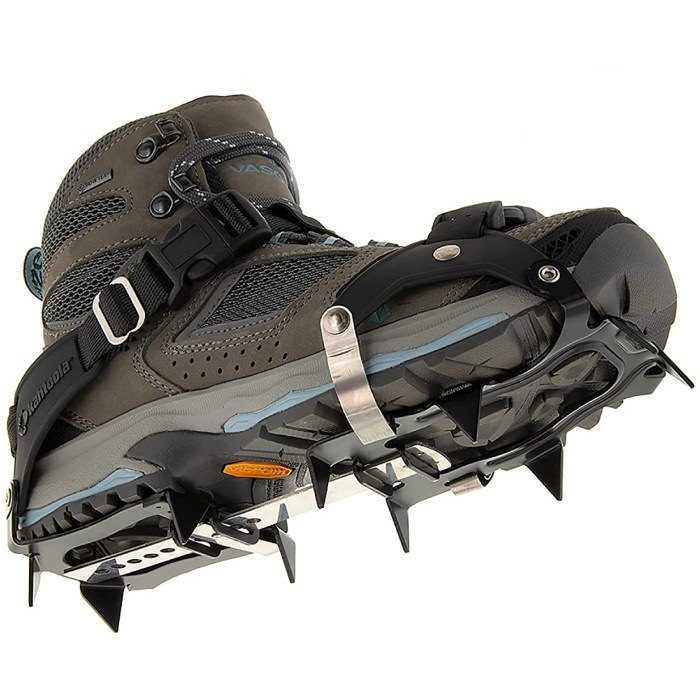
Kahtoola K10
Best Semi-Technical Spikes
CleverHiker Rating: 4.4/5.0
Price: $120
Weight: 1 lb. 7.6 oz.
Type: Strap-On Crampon
Best Use: Hiking & non-technical mountaineering
Pros
- Very aggressive traction
- Felxible
- Secure fit
- Easy on/off
Cons
- Expensive
- A bit heavier/bulky
- No stuff sack included
- Overkill for casual use
The Kahtoola K10 hiking crampons provide serious traction for the most challenging hikes in all winter conditions. They aren’t true crampons for tackling technical terrain, but they are about as close as it gets. Unlike true crampons, these work with hiking boots without compromising their mobility.
The ten ¾” spikes, made from a super durable chromoly steel, dig deeply into hard ice and packed snow with ease. They also are significantly more effective in deep snow than any of the other devices on our list. The spikes are strategically placed for optimum stability with two forward facing front spikes for gaining purchase on the steepest ice slopes.
The K-10’s strike a nice balance between rigidity and flexibility. The steel plates on the forefoot and heel provide the rigidity needed for confident footing on steep slopes while the Leafspring Flexbar Technology helps maintain the range of motion of a normal hiking boot. They’re still a little clumsy on dry, rocky trails but are way more nimble than true crampons. The K-10s are suitable for hiking boots and insulated winter boots.
The binding system is a bit tricky to use, but once you get the hang of it, these pseudo crampons stay securely on your feet. We recommend spending some time with them at home to avoid frustration on the trail.
The Kahtoola K-10s are a niche set of trail crampons – definitely not a do-it-all device. They’re best for people who already own a pair of lightweight spikes and want to level up their winter adventures to more challenging terrain. For a niche device, the large price tag is hard to swallow. But when you need that extra traction to keep you safe, the price is a minor concern.
More: Kahtoola K10 Full Review
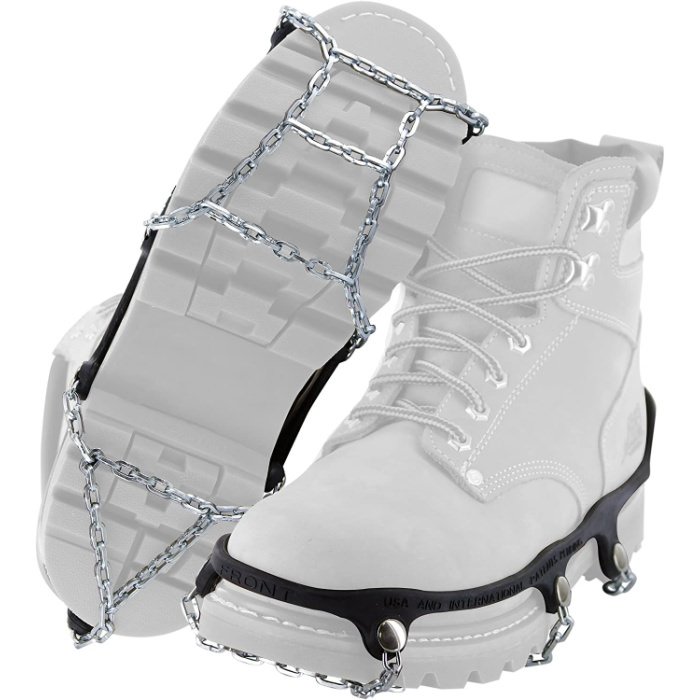
Yaktrax Chains
Best Budget Buy
CleverHiker Rating: 4.3/5.0
Price: $40
Weight: 9.6 oz.
Type: Chains
Best Use: Walking; mixed ice, gravel & hard surfaces
Pros
- Very affordable
- Durable
- Packable
- Works well on transitional surfaces
Cons
- Less durable
- Less aggressive traction
- No stuff sack included
For anyone looking for affordable, supplemental traction on less challenging winter terrain, the Yaktrax Chains are a solid option. They may not provide the grip of more aggressive alternatives, but they get the job done without breaking the bank.
Instead of relying on aggressive spikes, the Chains utilize hundreds of small metal edges that grip ice and packed snow from multiple angles. They don’t dig in deep, but they improve stability on moderately flat, packed trails and icy sidewalks. They aren’t ideal for deep snow or steep, rugged terrain and can feel awkward on dry, hard surfaces.
The Yaktrax Chains are easy to use, with a rubber harness that’s simple to slip over most running and hiking shoes. The cleats stay secure after some initial adjustments to dial in the fit but create a gap at the arch. The rubber harness is tight on boots, especially at the lower end of the size range.
While they aren’t the most durable option, the Yaktrax Chains offer great value for the price. The TIG-welded, case-hardened steel chains are a durable material, but the individual links are particularly vulnerable on rocky trails. The rubber harness is stiffer than most and shows some weakness in extreme cold. Still, given their low price, they’re a great option for light winter hikes, walks around town, or packed trails. For more serious adventurers, it’s worth exploring other more durable options for tougher terrain.
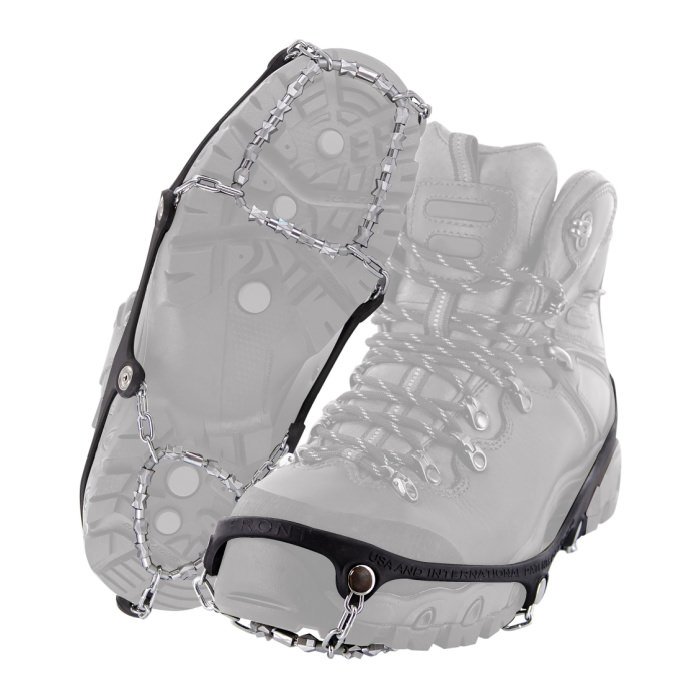
Yaktrax Diamond Grip
Best at Shedding Snow
CleverHiker Rating: 4.2/5.0
Price: $55
Weight: 9.7 oz.
Type: Steel beads
Best Use: Walking & light hiking
Pros
- Affordable
- Sheds snow well
Cons
- Not as durable as some
- Less aggressive traction
- Fit not as dialed in
- No stuff sack included
The Yaktrax Diamond Grips are a great budget buy for gentle use around town and on well maintained trails. The unique design of the patented Diamond Beads makes them uniquely suited for shedding snow in sticky spring conditions and transitions seamlessly across varying hiking surfaces.
The Diamond Grips shine brightest on packed snow, gravel, and dirt. Unlike larger spikes that are clumsy over rocky and dry terrain, the Diamond Grips feel almost like a regular hiking shoe. Although they provide decent grip on ice, the swiveling beads can sometimes backfire on the slipperiest surfaces.
The fit of these cleats is comfortable, secure, and lightweight. At just 137 grams per foot, they are hardly noticeable and create virtually zero foot fatigue. Although they can be a little tricky to take on and off and require some initial adjusting, they stay comfortable all day long across a wide range of conditions.
The unique design does come with a few caveats, however. The moving parts cause abrasion that can ultimately cause the cable to break over time. The rubber sling, although still elastic at most temperatures, can stiffen and crack in the most frigid environments. The attachment points, however, are incredibly robust.
Ultimately, we recommend the Yaktrax Diamond Grips for casual outings around town and the occasional hike on well maintained trails. The unique construction presents significant weak points which might not hold up to years of aggressive use.
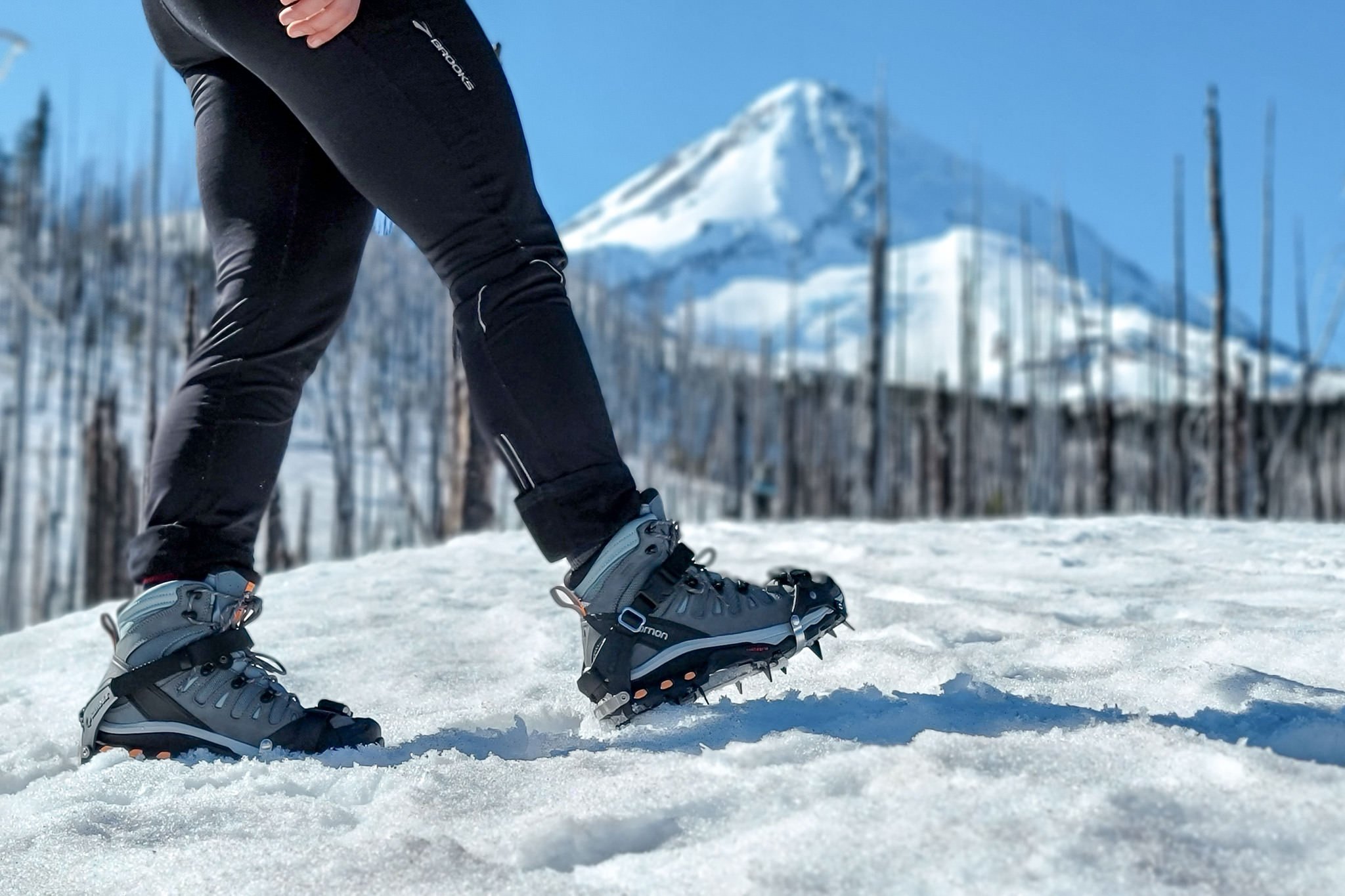
How We Test & Methodology
We spent weeks analyzing, hiking, and trail running in each pair of ice cleats to determine the best pair for every application. We evaluated all of the potential deal-breaking aspects including traction, fit, ease of use, versatility, weight and packability, and durability.
TRACTION
We started by noting the length, number, and shape of each devices’ spikes and then got out there and put them to the true test. We ran, hiked, and scrambled with each set of ice cleats on a variety of terrain and surfaces. We’re lucky to have the Colorado Rocky Mountains as our testing ground – where we can encounter mud, dirt, rocks, slush, packed snow, fresh snow of varying depths, ice, and even mixed ice and rock scrambles. After traveling miles upon miles on each pair of cleats, we judged their traction on construction and overall impression.
FIT
A traction device’s fit is determined by which type of footwear it is most compatible with, plus overall comfort and security. While some cleats are made to fit a wide range of footwear, others are specifically designed with boots or trail runners in mind.
Regardless of manufacturer recommendations, we hiked with each pair of cleats in every type of hiking footwear we had available (minus the elusive hiking flip flop). We took note of how well the cleats stayed in place on our feet and if the comfort changed throughout our hikes. Some cleats were perfectly suited for a given shoe while others squeezed too tightly or sagged.
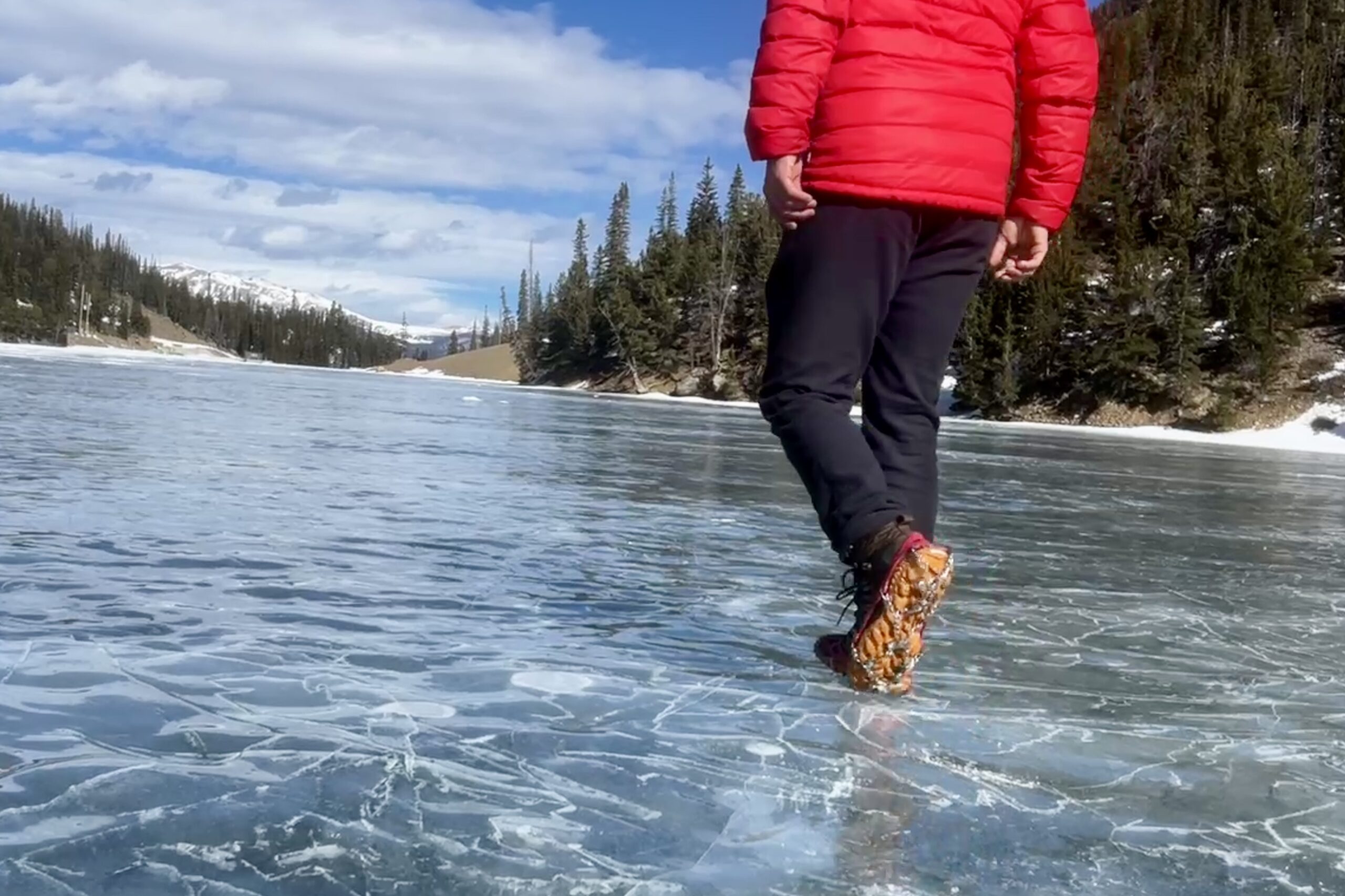
EASE OF USE
It’s nice to have gear that works. For ice cleats, that means elastic that has the right amount of stretch, handles that help pull them on and off, markings that clearly indicate the front from the back, and spikes that don’t clump up with snow. All of the cleats on our list have great user friendliness, but some rise above the rest for certain applications.
While some traction devices are specifically designed for a certain purpose – such as super-steep, icy mountain terrain, trail running, or casual walks around town – others strive to be the best all-around. We walked, ran, and hiked with each set of cleats across a wide range of terrain, noting when they felt awkward or began to fail.
WEIGHT & PACKABILITY
A traction devices’ weight and packability is important when considering how much fatigue they’ll add by having them on your feet all day or how much gear you’ll need to fit in your pack for a given trip.
For more challenging adventures when traction is required above all else, weight is of little concern. Trail runners, on the other hand, will appreciate as much weight savings as they can get.
Most of the devices on our list come with an included stuff sack, but some leave you needing to improvise and figure out how to hang them on the outside of your pack. An included stuff sack and smaller packed size equals a high score for packability.
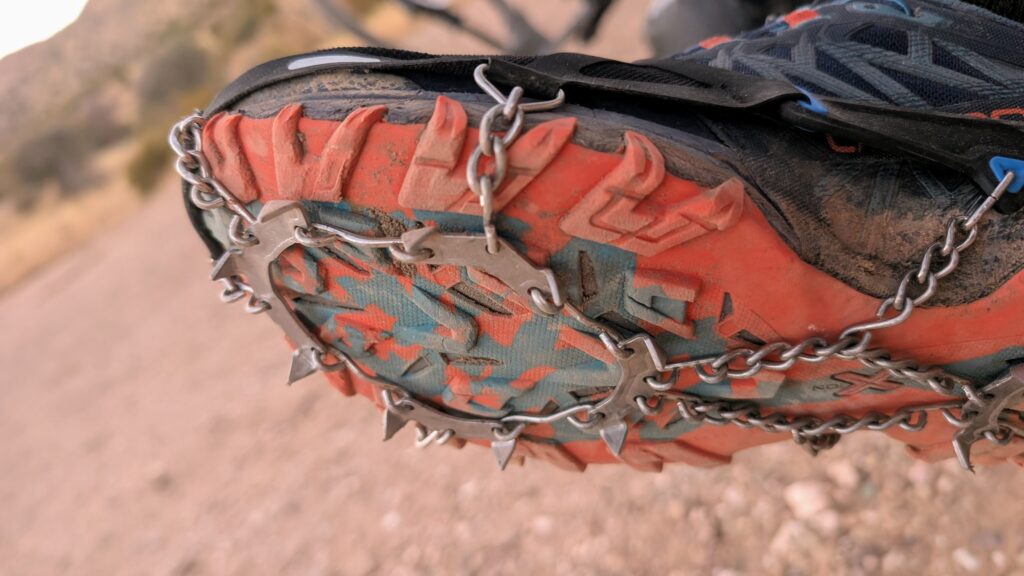
DURABILITY
When you spend hard-earned money on a pair of expensive traction devices, you want them to last a long time. Sometimes a higher investment equates to more durability, but that’s not always the case.
We graded durability on the spike’s material, overall construction and observation after extensive use. We even dug up the most notable user experiences from the web. To test how the rubber holds up in extreme cold, we left the cleats out overnight during an arctic blast in Colorado with temps down to -30ºF.
Spikes are made from a variety of different metals and alloys. In order from least to most durable, they could be carbon steel, heat treated stainless steel, case hardened steel alloy, hardened stainless steel, chromoly steel, or tungsten carbide.
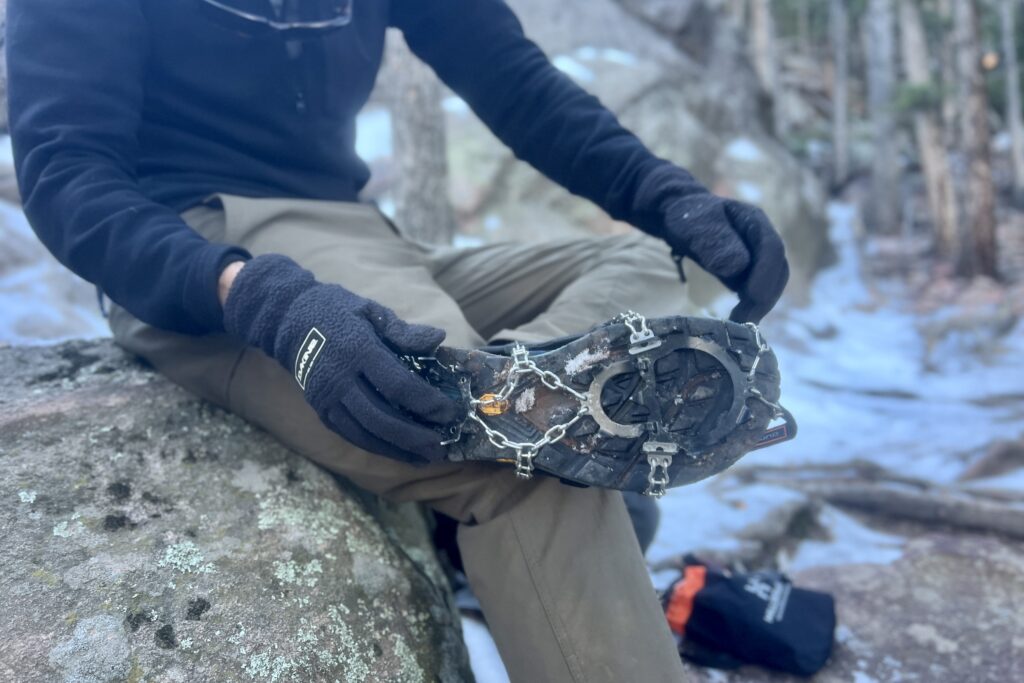
Why Trust CleverHiker
Gear Analyst Brett Kretzer has backpacked thousands of miles all over the world – from the Spanish Pyrenees to the humid forests of Appalachia and the soaring peaks of the Rocky Mountains. He has completed thru-hikes of the Long Trail, Colorado Trail (x2), GR11, Wonderland Trail, as well as several hundred mile sections on both the Appalachian Trail and Pacific Crest Trail.
Brett has been a professional gear analyst for about five gears, giving recommendations to aspiring adventurers, trail testing mountains of gear, and ruminating over the best alloy for crampons to grip ice. His attention to detail and years of experience of what works in the backcountry (and what doesn’t) makes him uniquely qualified to bring you sound gear advice.
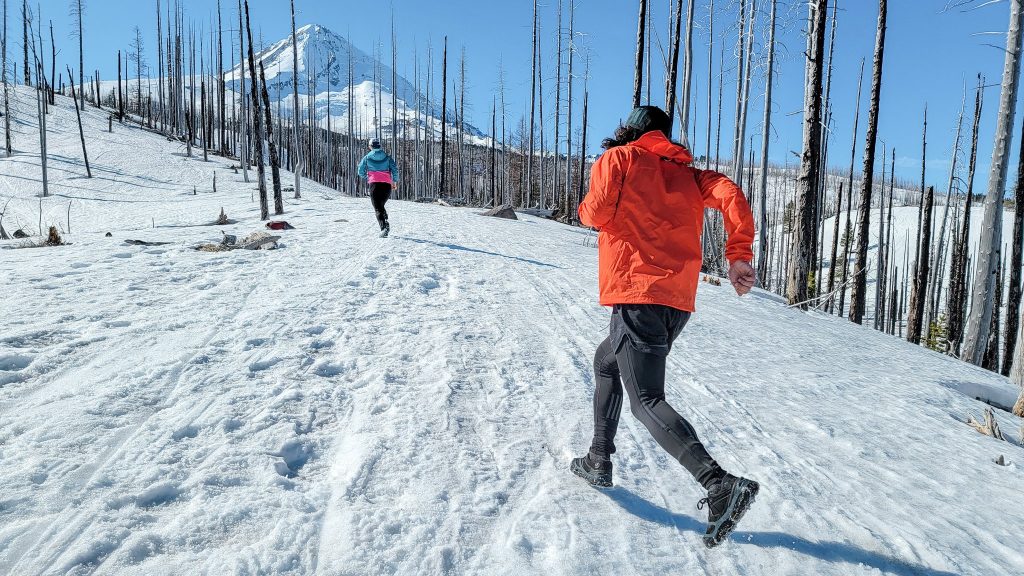
Analysis & Results
VALUE
At CleverHiker, value refers to how well products deliver compared to their cost. Kahtoola never ceases to impress us in the ice cleats category. They are consistently making quality traction devices at an affordable cost, like the Kahtoola MICROspikes and the Kahtoola EXOspikes. The EXOspikes are closest to the bottom right corner of the graph, indicating a high value and low cost.
The MICROspikes – though more expensive – have the value meter pretty much maxed out. They provide the perfect amount of traction to span a wide range of uses, are well made, and remain lightweight and packable. Their price point is the mean across the whole list, but their performance is well above average.
This is not to say that other devices on the list aren’t worth the money. The Black Diamond Distance Spike is pricey but utilizes premium materials and innovative ideas to create the best running cleats possible. The Kahtoola K-10 is the most expensive option on our list, but it’s also the only one capable of climbing an icefall.
TRACTION
Traction is not as straightforward as you might think. Although a higher score in this metric is equal to more aggressive traction in general, stronger traction is not always better. Sometimes you want versatile, all-around traction, while other times you may want specialized traction for a certain type of terrain. So be sure to look into the nuances behind each device’s traction, and not just the overall score.
By far the most aggressive traction device on our list is the Kahtoola K-10. The ¾” steel spikes will dig deeply into hard ice with a swift kick and the sheer size of the spikes even help to stake your foot into deep snow. The next aggressive cleats are the Hillsound Trail Crampons. The Trail Crampons lack the rigid structure of the K-10’s, but are more akin to lightweight spikes that pack well and work across a wider range of mountain terrain.
The Kahtoola MICROspikes and the Black Diamond Distance Spike follow closely behind as we head into more versatile traction territory. Both are made with fairly aggressive spikes while beginning to shift priority towards weight savings and versatility.
FIT
For this metric we took a look at how well each set of cleats fits on different types of footwear – running shoes, hiking shoes, hiking boots, and insulated boots. We took note of how well the cleats stayed on our feet during a hike as well as overall comfort.
Most cleats did well in this metric but the Black Diamond Distance Spike, Hillsound Trail Crampon, and Kahtoola EXOspikes really stood out. The Distance Spike features an innovative softshell toe cap design that keeps the spikes ultralight and comfortably hugs a pair of trail runners. The Hillsound Trail Crampons stay extra secure with their top strap and the EXOspikes are lightweight and comfortable enough for prolonged use.
EASE OF USE
The bulk of this metric leans in the direction of versatility – how well each device performs across a wide range of conditions including dry ground, rocks, ice, packed snow, loose snow, and gradual or steep slopes. We also considered how well each device is designed for user friendliness.
The Kahtoola MICROspikes came out on top for their excellent versatility, which is also what inspired us to name them “best ice cleats overall”. They are aggressive when you need them to be but are low profile enough to manage travel over dry and rocky terrain. The construction features Kahtoola’s Thermoplastic Elastomer harness that is comfortable and easy to use.
The Black Diamond Distance Spike also impressed us with its innovative design that easily distinguishes the front from the back and includes thoughtful handles for easy adjusting. Just as user friendly although not as versatile are the Hillsound Trail Crampons and the Kahtoola EXOspikes.
WEIGHT & PACKABILITY
Weight and packability are pretty straightforward. Devices with a lighter weight decrease the amount of foot fatigue caused by wearing them but are usually less grippy. Ice cleats with great packability usually include a stuff sack and collapse down to a conveniently small size.
Thanks largely to their soft shell toe cap, the Black Diamond Distance Spikes are incredibly lightweight and pack down in their stuff sack to about the size of an orange. They only add about two ounces of material to each foot so that you can keep going and going and going.
The Kahtoola NANOspikes and Kahtoola EXOspikes are both slightly heavier – an ounce more per foot – but are almost unnoticeable on the feet. The NANOspikes are geared more towards road running, with their small studs and textured plastic plates, and the EXOspikes are geared more towards trail running with their open design and raised lugs.
DURABILITY
Determining a product’s long term durability can be tough without years of use. Luckily, there are some clues in a product’s construction. The most durable traction devices on our list are the Kahtoola K-10’s. Their chromoly steel spikes are incredibly wear resistant and there are no rubber components to deteriorate over time. The frame is built on solid steel plates and a flexible steel bar.
The Kahtoola MICROspikes and Kahtoola EXOspikes are also impressively durable. The MICROspikes’ stainless steel spikes are durable enough to hold up to a fair amount of rock bashing and the chain links make for easy repair if one pops loose. The EXOspikes’ traction is made from tungsten carbide studs which are 100 times more wear resistant than steel. Both pairs feature Kahtoola’s durable Thermoplastic Elastomer harness that retains its elasticity even in the most frigid conditions.
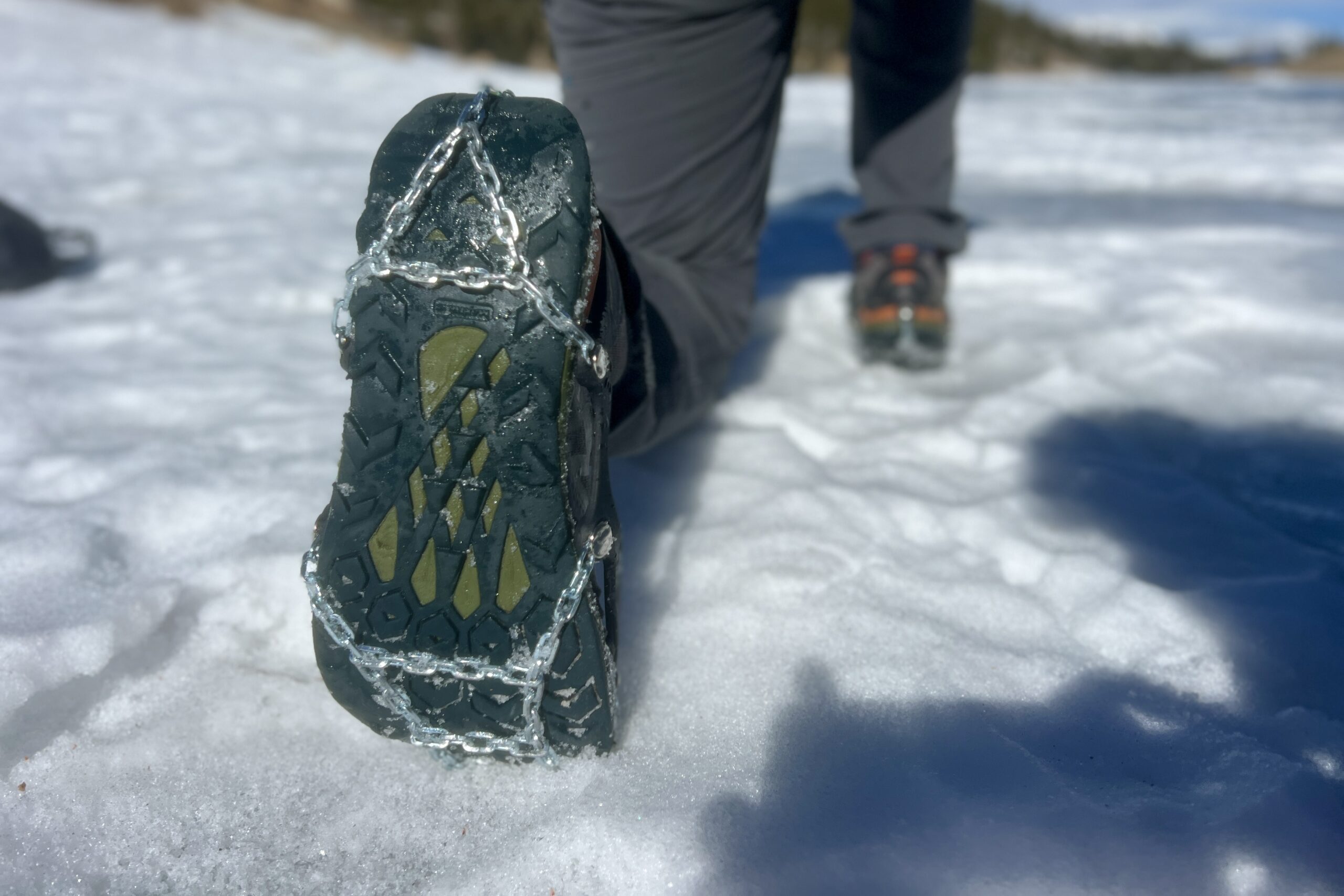
Conclusion
Sifting through the sea of minute details and differences in traction devices can be an overwhelming task. Fortunately, bringing you real, trail-tested recommendations is our passion! So whether you’re tackling a demanding winter summit or casually jogging around icy city streets, we hope that we have helped guide you towards finding your perfect pair of ice cleats. Happy Trails!



